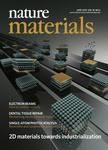版权所有:内蒙古大学图书馆 技术提供:维普资讯• 智图
内蒙古自治区呼和浩特市赛罕区大学西街235号 邮编: 010021

作者机构:Department of Chemistry The University of Chicago Chicago IL USA Center for Functional Nanomaterials Brookhaven National Laboratory Upton NY USA Department of Chemical Engineering Columbia University New York NY USA Department of Applied Physics and Applied Mathematics Columbia University New York NY USA
出 版 物:《NATURE MATERIALS》 (自然材料)
年 卷 期:2019年第18卷第2期
页 面:186-186页
核心收录:
学科分类:08[工学] 0805[工学-材料科学与工程(可授工学、理学学位)] 080502[工学-材料学] 0703[理学-化学] 0702[理学-物理学]
基 金:Basic Energy Sciences, BES University of Chicago U.S. Department of Energy, USDOE Martha Ann and Joseph A. Chenicek Graduate Research Fund Howard Hughes Medical Institute, HHMI National Science Foundation, NSF, (DMR-1555361, DMR-1555361) National Science Foundation, NSF Division of Materials Sciences and Engineering, DMSE, (DE-SC0008772) Division of Materials Sciences and Engineering, DMSE US DOE Office of Science Facilities, (DE-SC0012704)
主 题:Nanoparticles Optical materials
摘 要:Surface encoding of colloidal nanoparticles with DNA is fundamental for fields where recognition interaction is required, particularly controllable material self-assembly. However, regioselective surface encoding of nanoparticles is still challenging because of the difficulty associated with breaking the identical chemical environment on nanoparticle surfaces. Here we demonstrate the selective blocking of nanoparticle surfaces with a diblock copolymer (polystyrene-b-polyacrylic acid). By tuning the interfacial free energies of a ternary system involving the nanoparticles, solvent and copolymer, controllable accessibilities to the nanoparticles’ surfaces are obtained. Through the modification of the polymer-free surface region with single-stranded DNA, regioselective and programmable surface encoding is realized. The resultant interparticle binding potential is selective and directional, allowing for an increased degree of complexity of potential self-assemblies. The versatility of this regioselective surface encoding strategy is demonstrated on various nanoparticles of isotropic or anisotropic shape and a total of 24 distinct complex nanoassemblies are fabricated.